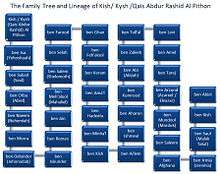Qais Abdur Rashid

Qais Abdur Rashīd or Qays ʿAbd ar-Rashīd (Pashto: قيس عبد الرشيد) is said to be the legendary founding father of the Pashtun nation. Qais is said to have traveled to Mecca and Medina in Arabia during the early days of Islam.[1]
According to the legend, Qais had three sons: Sarbaṇ (سربڼ), Beṭ (بېټ), and Gharghax̌t (غرغښت).[2] His sons founded three tribal confederacies named after them: Sarbani, Bettani, and Gharghashti. Qais also had an adopted son, Karlani tribe Ormur Baraki who is progenitor of the Karlani tribe .[3] There are multiple versions of the legend, including several regional variants that mention only one, two, or three of the four legendary brothers.

Genealogical tree
Some Afghan genealogies list Qais as the 37th descendant of King Talut (or Saul, reigned c. 1050 BC–1010 BC) through Malik Afghana, a legendary grandson of Talut.[4][5][6]
The British Indian administrator Muhammad Hayat Khan, in his book Hayāt-e Afghānī (حیات افغانی; orig 1865, English translation 1874), writes that Qais was the 101st descendant of Saul through Saul's son Yehonatan.[7]
According to the Encyclopaedia of Islam, the theory of Pashtun descent from the ancient Israelites is traced to Tārīkh-e Khān Jahānī wa Makhzan-e Afghānī (تاریخ خان جهانی ومخزن افغانی), a history compiled by Nimat Allah al-Harawi during the reign of the Mughal emperor Jahangir in the 17th century. The Makhzan-e Afghānī's Israelite theory, however, has been dismissed by modern authorities due to numerous historical and linguistic inconsistencies.
Legend
Legend has it that Qais was born in the Ghor region of present-day central Afghanistan. Upon hearing about the advent of Islam, his tribe sent him to Medina in the Arabian Peninsula, in present-day Saudi Arabia. He met the Prophet Muhammad and embraced Islam there, and was given the name Abdur Rashīd by the Prophet. He then returned to Ghor and introduced Islam to his tribe. According to Mountstuart Elphinstone, in legend the famous military leader and companion of Muhammad, Khalid ibn al-Walid, introduced Qais to the Prophet Muhammad.
The Afghan historians proceed to relate that the Jewish tribe, both in Ghor and in Arabia, preserved their knowledge of the unity of God and the purity of their religious belief, and that on the appearance of the last prophet and messenger, Prophet Muhammad, the Afghans of Ghor listened to the invitation of their Arabian brethren, the chief of whom was Khalid ibn al-Waleed, so famous for his conquest of Syria, and marched to the aid of the true faith, under the command of Kyse, afterwards surnamed "Abdul Rasheed".[8]
Settlement
One legend has it that when Qais felt his time was near, he asked his sons to take him from Ghor to the Sulaiman Mountains and bury him at the spot where his ancestor Malik Afghana was buried, and he was buried on top of Takht-e-Sulaiman ("Throne of Solomon"), also called Da Kasī Ghar (د کسي غر, "Mount of Qais"), located near the village of Darazinda in Frontier Region Dera Ismail Khan of the Federally Administered Tribal Areas of Pakistan, close to Frontier Region Dera Ismail Khan's borders with both South Waziristan and Zhob District, Balochistan. Some people visit the place, mostly in the summer, since in winters the snowfall makes it difficult to climb, and sacrifice an animal, usually a sheep or a goat at the tomb of Qais.
According to another legend, however, Qais settled in the Balkh region of present-day northern Afghanistan. From there, his different descendants migrated south, west, and east.[3]
Genetics
There is, however, no strong evidence to show any genealogical connection between the present-day Pashtuns and the ancient Semitic-speaking Israelites. DNA shows that Pashtuns have several Y-haplogroups, although R1a makes up about 51% among Pashtuns.[9] Hence, Pashtuns have a significant affinity with their neighboring Indo-European speaking ethnic groups,[9] and most present-day Pashtuns descended from the original Indo-European population who have lived in the territory by other names, such as Scythians,(Indo-Iranians), and their forebears.
See also
- Amir Kror Suri, a legendary 8th-century Pashtun prince from Ghor
- Amir Suri, a pagan Ghorid king in the 9th and 10th century who was defeated in war with the Saffarid emir Ya'qub ibn al-Layth al-Saffar
- Lech, Czech, and Rus, three legendary brothers who are said to have founded the three modern Slavic nations of Poles (or Lechites), Czechs, and Rus' (or Russians, Ukrainians, and Belarusians)
- Fénius Farsaid, a legendary Scythian prince who is said to have founded the modern Irish nation and invented the Ogham Irish alphabet
References
- ↑ Meaning and Practice, Afghanistan Country Study: Religion, Illinois Institute of Technology (retrieved 18 January 2007).
- ↑ Qais Abdul Rasheed. Khyber.ORG.
- 1 2 Coyle, Dennis Walter (August 2014). "Placing Wardak among Pashto varieties" (PDF). University of North Dakota:UND. Retrieved 26 December 2014.
- ↑ Dawn, The cradle of Pathan culture Archived December 5, 2008, at the Wayback Machine., by Alauddin Masood, 4 April 2004.
- ↑ Pakistan pictorial, Pakistan Publications, 2003.
- ↑ Niamatullah's history of the Afghans, Volume 1, Niʻmat Allāh, Nirod Bhusan Roy, Santiniketan Press, 1958, pg. 5.
- ↑ Hayat i Afghan, Section on Tareen tribe, Appendix 4 to the original Persian text by Nawab Muhammad Hayat Khan, published Lahore, 1865. English translation by HB Priestley, Lahore, 1874
- ↑ Life of the Amir Dost Mohammed Khan; of Kabul, Volume 1. By Mohan Lal (1846), quoting Mountstuart Elphinstone pg. 5
- 1 2 Haber M, Platt DE, Ashrafian Bonab M, Youhanna SC, Soria-Hernanz DF, et al. (2012). "Afghanistan's Ethnic Groups Share a Y-Chromosomal Heritage Structured by Historical Events". PLoS ONE. 7 (3): e34288. doi:10.1371/journal.pone.0034288. PMC 3314501
 . PMID 22470552.
. PMID 22470552.